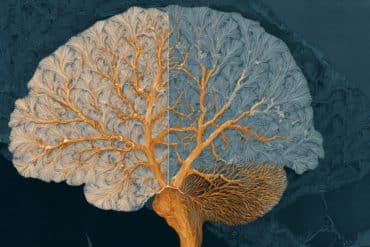Summary: Researchers have created an artificial nervous system that may give prosthetics and robots reflexes and the ability to sense touch. The system is sensitive enough to identify letters in the Braille alphabet.
Source: Stanford.
Stanford and Seoul National University researchers have developed an artificial sensory nerve system that can activate the twitch reflex in a cockroach and identify letters in the Braille alphabet.
The work, reported May 31 in Science, is a step toward creating artificial skin for prosthetic limbs, to restore sensation to amputees and, perhaps, one day give robots some type of reflex capability.
“We take skin for granted but it’s a complex sensing, signaling and decision-making system,” said Zhenan Bao, a professor of chemical engineering and one of the senior authors. “This artificial sensory nerve system is a step toward making skin-like sensory neural networks for all sorts of applications.”
Building blocks
This milestone is part of Bao’s quest to mimic how skin can stretch, repair itself and, most remarkably, act like a smart sensory network that knows not only how to transmit pleasant sensations to the brain, but also when to order the muscles to react reflexively to make prompt decisions.
The new Science paper describes how the researchers constructed an artificial sensory nerve circuit that could be embedded in a future skin-like covering for neuro-prosthetic devices and soft robotics. This rudimentary artificial nerve circuit integrates three previously described components.
The first is a touch sensor that can detect even minuscule forces. This sensor sends signals through the second component – a flexible electronic neuron. The touch sensor and electronic neuron are improved versions of inventions previously reported by the Bao lab.
Sensory signals from these components stimulate the third component, an artificial synaptic transistor modeled after human synapses. The synaptic transistor is the brainchild of Tae-Woo Lee of Seoul National University, who spent his sabbatical year in Bao’s Stanford lab to initiate the collaborative work.
“Biological synapses can relay signals, and also store information to make simple decisions,” said Lee, who was a second senior author on the paper. “The synaptic transistor performs these functions in the artificial nerve circuit.”
Lee used a knee reflex as an example of how more-advanced artificial nerve circuits might one day be part of an artificial skin that would give prosthetic devices or robots both senses and reflexes.
In humans, when a sudden tap causes the knee muscles to stretch, certain sensors in those muscles send an impulse through a neuron. The neuron in turn sends a series of signals to the relevant synapses. The synaptic network recognizes the pattern of the sudden stretch and emits two signals simultaneously, one causing the knee muscles to contract reflexively and a second, less urgent signal to register the sensation in the brain.
Making it work
The new work has a long way to go before it reaches that level of complexity. But in the Science paper, the group describes how the electronic neuron delivered signals to the synaptic transistor, which was engineered in such a way that it learned to recognize and react to sensory inputs based on the intensity and frequency of low-power signals, just like a biological synapse.
The group members tested the ability of the system to both generate reflexes and sense touch.
In one test they hooked up their artificial nerve to a cockroach leg and applied tiny increments of pressure to their touch sensor. The electronic neuron converted the sensor signal into digital signals and relayed them through the synaptic transistor, causing the leg to twitch more or less vigorously as the pressure on the touch sensor increased or decreased.
They also showed that the artificial nerve could detect various touch sensations. In one experiment the artificial nerve was able to differentiate Braille letters. In another, they rolled a cylinder over the sensor in different directions and accurately detected the direction of the motion.

Bao’s graduate students Yeongin Kim and Alex Chortos, plus Wentao Xu, a researcher from Lee’s own lab, were also central to integrating the components into the functional artificial sensory nervous system.
The researchers say artificial nerve technology remains in its infancy. For instance, creating artificial skin coverings for prosthetic devices will require new devices to detect heat and other sensations, the ability to embed them into flexible circuits and then a way to interface all of this to the brain.
The group also hopes to create low-power, artificial sensor nets to cover robots, the idea being to make them more agile by providing some of the same feedback that humans derive from their skin.
Funding: This work was funded by the Ministry of Science and ICT, Korea; by Seoul National University (SNU); by Samsung Electronics; by the National Nanotechnology Coordinated Infrastructure; and by the Stanford Nano Shared Facilities (SNSF). Patents related to this work are planned.
Zhenan Bao is also a senior fellow of the Precourt Institute for Energy, a member of Stanford Bio-X and of the Stanford Neurosciences Institute, a faculty fellow at Stanford ChEM-H, an affiliate of Stanford Woods Institute for the Environment, and a founder and faculty director of the Stanford Wearable Electronics Initiative (eWEAR). Stanford researchers Yuxin Liu, Jin Young Oh, Donghee Son, Jiheong Kang, Amir M. Foudeh, Chenxin Zhu, Simiao Niu, Jia Liu and Raphael Pfattner all participated in the work. Team member Yeongjun Lee is affiliated with Seoul National University. Alex Chortos is now a postdoctoral scholar at Harvard.
Source: Stanford
Publisher: Organized by NeuroscienceNews.com.
Image Source: NeuroscienceNews.com image is credited to Kevin Craft.
Original Research: Abstract for “A bioinspired flexible organic artificial afferent nerve” by Yeongin Kim, Alex Chortos, Wentao Xu, Yuxin Liu, Jin Young Oh, Donghee Son, Jiheong Kang, Amir M. Foudeh, Chenxin Zhu, Yeongjun Lee, Simiao Niu, Jia Liu, Raphael Pfattner, Zhenan Bao, and Tae-Woo Lee in Science. Published June 1 2018.
doi:10.1126/science.aao0098
[cbtabs][cbtab title=”MLA”]Stanford “Artificial Nerve System Gives Prosthetic Devices and Robots a Sense of Touch.” NeuroscienceNews. NeuroscienceNews, 1 June 2018.
<https://neurosciencenews.com/artificial-nerve-robot-prosthetics-9213/>.[/cbtab][cbtab title=”APA”]Stanford (2018, June 1). Artificial Nerve System Gives Prosthetic Devices and Robots a Sense of Touch. NeuroscienceNews. Retrieved June 1, 2018 from https://neurosciencenews.com/artificial-nerve-robot-prosthetics-9213/[/cbtab][cbtab title=”Chicago”]Stanford “Artificial Nerve System Gives Prosthetic Devices and Robots a Sense of Touch.” https://neurosciencenews.com/artificial-nerve-robot-prosthetics-9213/ (accessed June 1, 2018).[/cbtab][/cbtabs]
Abstract
A bioinspired flexible organic artificial afferent nerve
The distributed network of receptors, neurons, and synapses in the somatosensory system efficiently processes complex tactile information. We used flexible organic electronics to mimic the functions of a sensory nerve. Our artificial afferent nerve collects pressure information (1 to 80 kilopascals) from clusters of pressure sensors, converts the pressure information into action potentials (0 to 100 hertz) by using ring oscillators, and integrates the action potentials from multiple ring oscillators with a synaptic transistor. Biomimetic hierarchical structures can detect movement of an object, combine simultaneous pressure inputs, and distinguish braille characters. Furthermore, we connected our artificial afferent nerve to motor nerves to construct a hybrid bioelectronic reflex arc to actuate muscles. Our system has potential applications in neurorobotics and neuroprosthetics.







